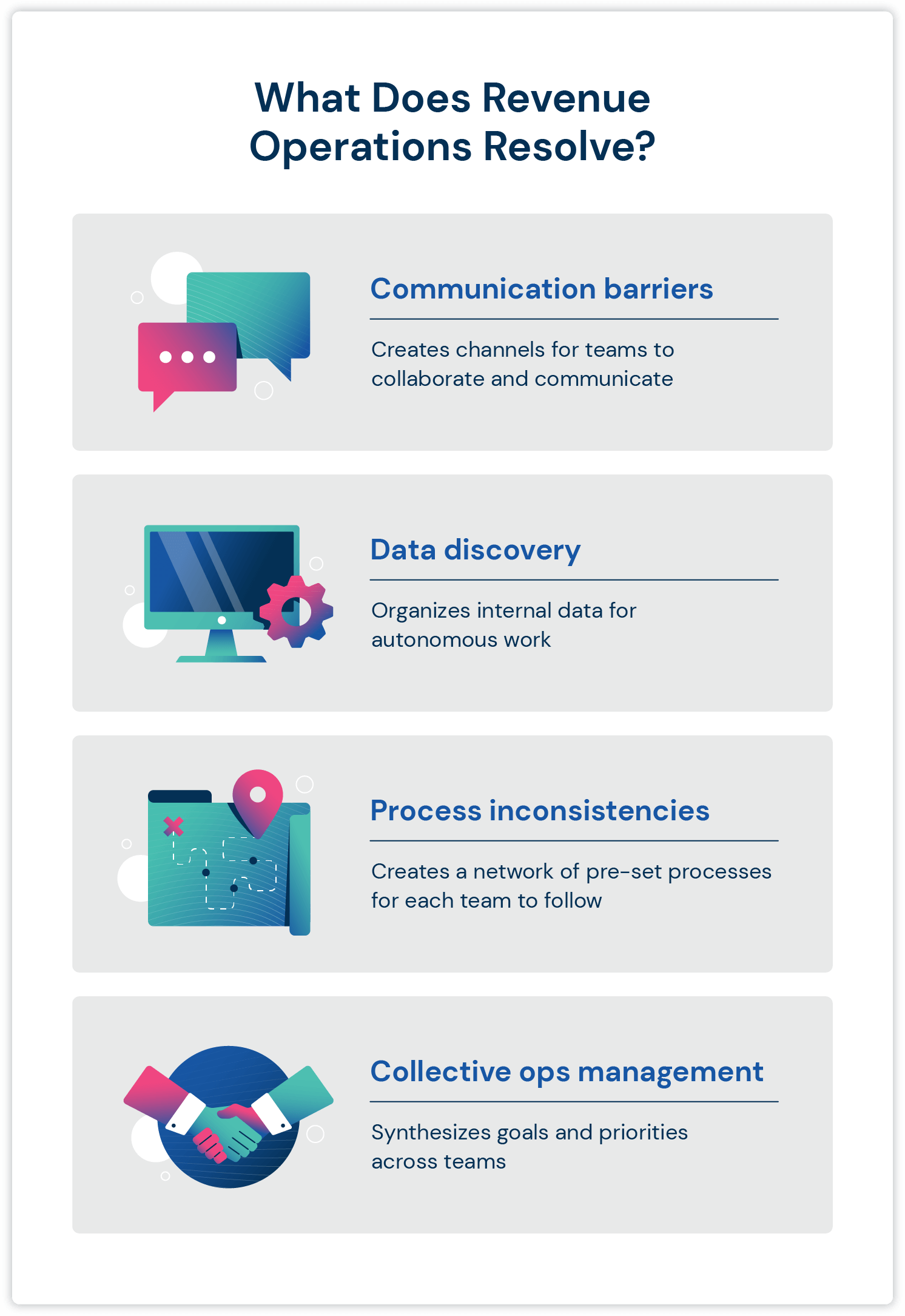What Is Revenue Operations (RevOps) and Why Do You Need It?

Contents
Revenue operations is a missing key for many businesses to improve internal efficiency. So, what is revenue operations? It’s the idea that companies should have a team whose purpose is to connect sales, customer success and marketing operations.
RevOps is truly the future of business — 75% of the highest growth companies in the world are expected to implement a revenue operations plan by 2025.
Through easier communication and data sharing, these teams can better support customers and achieve bullish revenue growth goals. Essentially, it allows internal teams with direct ties to revenue to focus on productive tasks.
What Is Revenue Operations?
Revenue Operations is a team whose goal is to streamline the sales process for better customer experience and profitability. They do this by reducing internal data silos to improve cross-team communication.
Data silos occur when a company struggles to access internal data. For example, if you need to email a colleague for an internal document and can’t search for it yourself, you’re encountering a data silo.
If data is shared freely between teams, team members can work independently as needed, collaborate better and get more done. This ultimately allows employees to focus on supporting UX and the customer experience throughout the sales process.
A RevOps team can help you solve common problems with your revenue teams, including:
- Communication barriers: creates channels for teams to collaborate and communicate
- Data discovery: organizes internal data for autonomous and asynchronous work
- Process inconsistencies: creates a network of pre-set processes for each team to follow
- Collective ops management: synthesizes goals and priorities across teams

To direct your RevOps plan, it’s helpful to think of the three pillars of revenue operations:
- Process
- Platform
- People
These are the basic tenets of RevOps that most companies use. To level up your strategy, add the fourth category, Data, which isn’t a pillar but is still important for your RevOps team to measure their successes.
Process
Revenue operations is all about planning ahead to create a seamless customer experience. When each team member has a clearly defined role, revenue teams can work as a united front to support company growth and move customers through the sales funnel.
Platform
The right tools make all the difference in revenue operations. Many digital marketing tools automatically track or gather data to reduce human error and improve workflows.
Common tools like a CRM platform can help your team:
- Track where prospects are in the sales funnel
- Use AI to interpret large datasets and analyze prospects
- Forecast revenue or other success metrics
- Gather qualitative or quantitative data about prospects
People
Revenue operations isn’t a one-size-fits-all solution, so your team should be built to align with overarching revenue goals. Consider hiring for the following positions to get your revenue operations department started:

- Revenue Operations Lead: oversees all aspects of revenue operations and reports to the executive team
- Project Management Lead: oversees the department’s project management goals and reports to the Revenue Operations Lead
- Project Management Team: executes day-to-day project management tasks and reports to the Project Management Lead
- Analytics Lead: oversees the department’s data and analytics goals and reports to the Revenue Operations Lead
- Analytics Team: collects and analyzes revenue data and reports to the Analytics Lead
- Platform Lead: oversees L&D for any tools or platforms the revenue operations department uses and reports to the Revenue Operations Lead
- Platform Team: provides daily support and maintains tools and platforms, and reports to the Platform Lead
Data
Revenue operations is different from other operations teams because their primary focus is on handling data. Poor data sharing or interpretations lead to miscommunication that can snowball and negatively affect the customer experience. This is a widespread problem — 30% of companies report struggling with data silos.
When you hire a RevOps team, their main concern is gathering and interpreting data. This allows your company’s entire revenue system to be more accurate, consistent and efficient when they’re moving clients through the pipeline.
Just as RevOps teams work with data from the marketing, sales and customer success departments, they should gather internal data as well. This gives you the full picture of which teams need more support.
Revenue Operations Team Structure
Your RevOps team might look a little different depending on your company’s needs, but it’s still useful to see which positions make up a typical RevOps team. Here are some other common teams to consider when expanding your revenue operations department:
- Operations management
- Sales enablement
- Learning and development
Revenue Operations vs. Sales Operations
Revenue operations teams handle sales data so the sales, marketing and customer success teams can focus on the core of what they do. Sales operations teams execute a similar function but for the sales department only. They’re like sports teams — sales operations teams work on your offensive strategy while revenue operations teams are on the defense.
It can be difficult to understand how these teams operate differently. Here are some examples.
Revenue operations tasks:
- Collect and analyze data from revenue teams
- Increase efficiency by identifying bottlenecks
- Support multiple teams for a better customer experience
Sales operations tasks:
- Own strategic sales planning
- Improve sales process efficiency
- Support the sales team

Revenue Operations Success Metrics
Without a way to measure success, it’s nearly impossible to tell if your revenue operations plan is effective. Revenue alone isn’t an effective metric because there are so many different resources that contribute to acquiring a new customer.
Multiple success metrics are necessary to give you the full picture of what works and what doesn’t with your new RevOps plan. Try choosing some metrics that align with your goals to measure your plan’s success. Some common metrics you can use to measure your RevOps team’s success are:
Win rates: the number of conversions for a sales team within a given period
Sales cycle time: the average amount of time it takes to close a deal
Pipeline velocity: the speed at which sales move through the pipeline
Customer acquisition cost (CAC): the estimated cost of gaining a single customer
Forecast accuracy: measures how accurately the sales team predicts their success
Customer lifetime value (CLV): estimated value of a specific customer for the duration of their relationship with a company
Customer churn: the rate at which a company loses customers
Renewals: the number or rate at which customers renew their contract with a company
Upsells: the number or rate at which customers upgrade or expand their contract with a company
Annual recurring revenue (ARR): the value of any subscription or contract-based revenue
How To Implement Revenue Operations
There’s no better time to implement a RevOps plan to ensure your business’s future success and scale up your team’s efficiency. Follow these basic steps to set your company on the path to continued growth and efficiency.

1. Audit Current Processes
The first step to implementing a revenue operations strategy is to audit your current sales process. The goal of RevOps is to streamline processes for a better UX, so it’s important to identify current pain points or strengths for better results.
First, you should identify the buyer life cycle and analyze any pain points in your current strategy, tech or processes. You shouldn’t assume that you’re doing everything wrong. If you can edit existing processes rather than starting anew, you’ll increase your ROI.
To decide which processes to target, identify the main points of conversions for your company. Knowing what works or doesn’t for these value-driving processes gives you an effective base for implementing the rest of your RevOps strategy.
2. Identify Your Revenue Pipeline
RevOps focuses on connecting revenue teams, which are typically made up of the sales, customer success and marketing departments. To ensure that these departments work together seamlessly, create a detailed pipeline for each revenue department to identify any gaps or overlaps.
You’ll need to determine which department is responsible going forward. It’s helpful to run surveys asking revenue departments which sales tools and technology they’re using daily and if there are any that teams aren’t using at all.
Once you’ve identified issues in your pipeline or revenue team tools, use your RevOps team to help optimize these workflows. The goal is to take operations or project management tasks off of specialized teams’ plates to help customers move along the pipeline smoothly.
3. Build Your RevOps Team
Now that you’ve identified your pipeline’s strengths, weaknesses and gaps, you can build your ideal RevOps team without wasting resources. Meet with leaders from your revenue departments to brainstorm example workflows and a new GTM plan. Centralizing GTM plans like this could help you increase your ROI by 20% or more.
At this point, you’ll also want to create inbound and outbound sales process documents. Consistency is the key to creating measurable success, so you can measure which strategies are most effective.
You should also implement a plan for monitoring your revenue pipeline and spot any bottlenecks. Tools like Mailshake or shared project trackers simplify communication so you can find these issues quickly and tackle what matters most.
4. Review RevOps Goals
Revenue operations has a reputation for being difficult to implement. A reason for this is that many companies fail to set up a plan for reviewing their revenue operations strategy. It can take some time and multiple revision rounds to determine what changes need to happen for success.
Some ways to ensure you’re revising your RevOps strategy as needed include setting up recurring 1v1s with department leads. During these meetings, team members can bring recurring or pressing issues to the table so that your revenue team evolves to fit your company’s needs.
Scale Your Sales With Mailshake
If you grow your revenue operations team early, you’ll save your company a lot of headaches later. It’s intimidating to start a new department from scratch and know who to hire, but there are plenty of tools like Mailshake’s sales engagement software that make the process easier.





